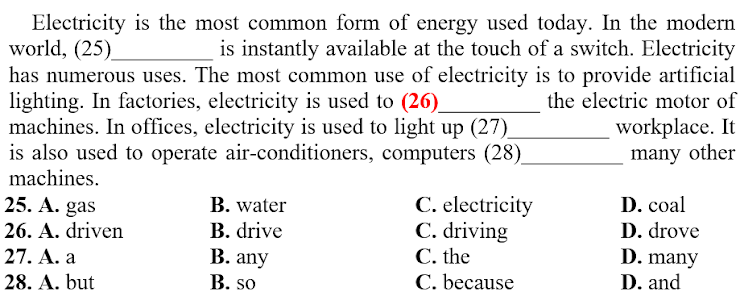Read the following passage and mark the letter A, B, C, or D on your answer sheer to indicate the correct answer to each of the numbered blanks from 37 to 44.
All mammals feed their young. Beluga whale mothers, for example, nurse their calves for some twenty months, until they are about to give birth again and their young are able to find their own food. The behavior of feeding of the young is built into the reproductive system. It is a nonselective part of parental care and the defining feature of a mammal, the most important thing that mammals – whether marsupials, platypuses, spiny anteaters, or placental mammals – have in common.
But not all animal parents, even those that tend their offspring to the point of hatching or birth, feed their young. Most egg–guarding fish do not for the simple reason that their young are so much smaller than the parents and eat food that is also much smaller than the food caten by adults. In reptiles, the crocodile mother protects her young after they have hatched and takes them down to the water, where they will find food, but she does not actually feed them. Few insects feed their young after hatching, but some make other arrangement provisioning their cells and nests with caterpillars and spiders that they have paralyzed with their venom and stored in a state of suspended animation so that their larvae might have a supply of fresh food when they hatch.
For animals other than mammals, then, feeding is not intrinsic to parental care. Animals add it to their reproductive strategies to give them an edge in their lifelong quest for descendants. The most vulnerable moment in any animal's life is when it first finds itself completely on its own, when it must forage and fend for itself. Feeding postpones that moment until a young animal has grown to such a size that it is better able to cope.
Young that are fed by their parents become nutritionally independent at a much greater fraction of their full adult size. And in the meantime those young are shielded against the vagaries of fluctuating of difficult–to–find supplies. Once a species does take the step of feeding its young, the young become totally dependent on the extra effort. If both parents are removed, the young generally do not survive.
What does the passage mainly discuss?
A. The care that various animals give to their offspring
B. The difficulties young animals face in obtaining
C. The methods that mammals use to nurse their young
D. The importance among young mammals of becoming independent


Kiến thức: Đọc hiểu
Giải thích:
Đoạn văn chủ yếu thảo luận về vấn đề gì?
A. Sự chăm sóc mà các loài động vật khác nhau dành cho con của chúng
B. Những khó khăn mà động vật trẻ gặp phải trong việc kiếm thức ăn
C. Các phương pháp mà động vật có vú sử dụng để nuôi con nhỏ
D. Tầm quan trọng của động vật có vú trẻ trở nên độc lập
Chọn A